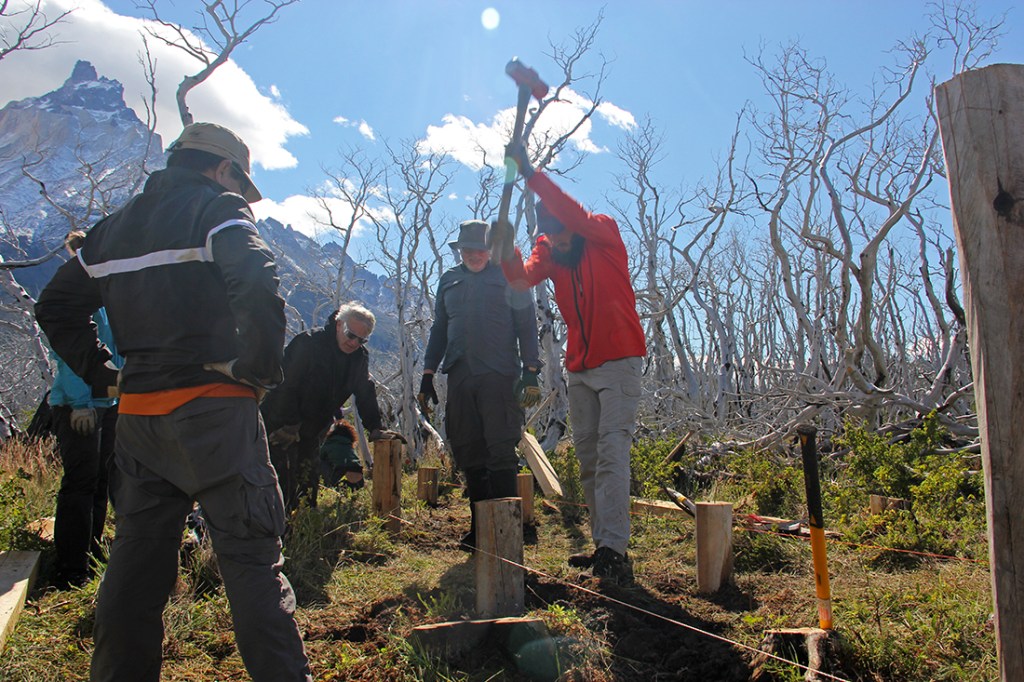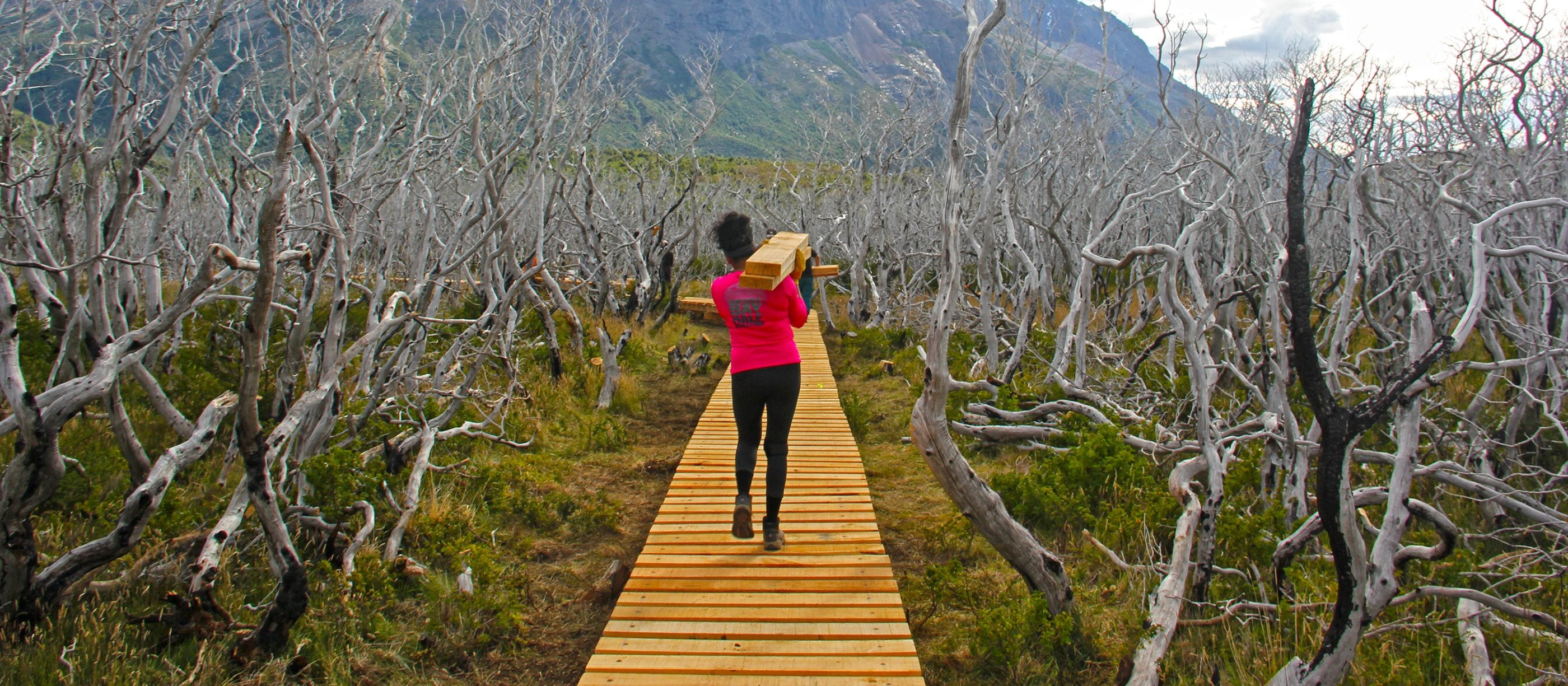A chainsaw whined in the rain, wind gusts moaned off the veiled mountainside, and though the naked tree trunks leaned as if tormented, the two dozen volunteers breaking trail never complained, as far as I could tell.
We’d come to Torres del Paine, Chile’s busiest national park, to lay a 560-foot boardwalk over a tract of sensitive moorland amid a forest of bone white trees. It would be the penultimate segment of a new five-mile trail that follows an old horse path, dispersing foot traffic along the park’s most heavily walked stretch.
“Here it comes.” Trip leader David Summer grinned over his chainsaw. I hunkered behind a shrub shield. The wind, doing 60, tore a screen of water off the lake and threw it at us. A regular February summer day in southern Patagonia.
“We are gonna find those times when you hit a wall, physically or emotionally,” David had warned us a few days before.
I was on swamper duty with a few others, numb hands tossing aside downed trees that David, a retired fire director with the U.S. Forest Service’s Pacific Northwest and Alaska regions, had hewn to forge a path for our boardwalk, which would also bridge a surging creek.
He’d been down here before with Conservation Volunteers International Program (Conservation VIP), a volunteer-based nonprofit whose work helps sustain landscapes, cultural sites and biodiversity around the globe, and the organization that organized our trip.
Conservation VIP works directly with the National Forest Corporation (CONAF), Chile’s national park service, which determines the park’s most pressing conservation needs. Michael Arcos, a technical coordinator for Torres del Paine, says support from collaborators like Conservation VIP makes important projects possible.
We’d volunteered to help preserve a harried landscape we’d never seen but wanted to. Now, like Torres del Paine’s barbed, glacier-hung peaks, our faces were hooded and inscrutable. But I sensed that, on our second day of work—shivering, wet, miserable—some had begun to wonder what I’d been wondering from the beginning: Why did we come here?

Volunteers work on a section of boardwalk in Torres del Paine. (Photo Credit: Nick Davidson)
Some 260,000 trekkers visit Torres del Paine each year, collectively straining the park’s aging infrastructure and trail systems. And since 2005, tourists have ignited all three of the park’s wildfires (lightning is rare), which have scorched a fifth of the park’s acreage.
The most recent wildfire burned from late-December 2011 into early March the next year. Open fires are forbidden in the park, but despite regulations, a man camping near Grey Glacier lit his toilet paper, lost hold of it, and the constant, gale force winds fanned the flames. More than 43,500 acres were charred on the forested ridges lining Lago Grey in the park’s central-eastern zone.
Human-caused erosion is more insidious. One of the most heavily trampled segments on the park’s W Circuit—named for its shape—sees extensive traffic on a regular basis. But on a truly wet day in Torres del Paine, hikers pummel the trails to sludge. Here and there, park rangers lay boards across the worst spots, but it’s often a losing battle.
Torres del Paine generates revenue by charging visitors for admission (roughly 6,000 pesos for Chileans and 21,000 pesos for foreigners) and by collecting fees from park concessionaires, similar to the National Park Service in the United States. Of all Chile’s national parks, Torres del Paine generates the most revenue. But the National Forest Corporation spreads that money across all its parks and leaves a meager budget for basic tasks, like trail maintenance, in Torres del Paine.
“Torres del Paine is the only park that generates significant revenue,” said Chris Braunlich, Conservation VIP’s CEO. “It’s similar to America’s National Park Service in that a large portion of the revenue goes to the NPS, then is redistributed. But [CONAF’s] budget is extremely limited compared to what you would expect in a U.S. park.”
In 2007, Chris and her husband, Richard, a civil and structural engineer, joined a group of volunteers who had identified major problems on the park’s trails and offered to help. Later that year, the trip’s leaders established Conservation VIP as a nonprofit comprised entirely of volunteers, and Chris, who had a background in finance, joined the board as CFO, before eventually becoming CEO. Chris and Richard have returned to Torres del Paine many times since.
Richard saw the park’s need for bridges and offered to design and build a few, including one completed in 2014 that spans 170 feet across a 15-story gorge near the foot of Grey Glacier. Yosemite National Park, Torres del Paine’s sister park, sent two of its staff to help.
Conservation VIP has fixed trails all around the park, but over the past two years, they’ve sent three volunteer groups to build the new, still-incomplete five-mile trail where we now worked, in a portion of the park with views that few have experienced.
The plan: connect the new trail to the old one, and create a one-way loop around Laguna Scottsberg to thin out hikers. When complete, it will be among the first new trails to be developed since the park’s inception in 1959. Torres del Paine was historically owned by a group of estancias whose land CONAF gradually bought. Its trails weren’t planned and cut; known as “use trails,” they were formed by someone walking or riding a horse along the easiest route.
This year’s work was different, because boardwalks require expensive materials to build. REI Adventures donated $30,000 to the Adventure Travel Conservation Fund, which awarded Conservation VIP the grant to build the boardwalk.
In preparation, Chris spent three weeks wrangling supplies and working with CONAF to ensure we’d accomplish our mutual objective. They’d helicopter the raw materials to the site, and we’d clear a path and start construction.
But Patagonian weather can be fickle for flying. When we hiked in, we saw we were short on wood. As is common in conservation, we’d have to reevaluate the meaning of success.

A volunteer hammers down on a wood peg under the jagged ramparts of Los Cuernos del Paine. (Photo Credit: Nick Davidson)
“This is not a drill on quantity,” David bellowed. “Measure three times, cut once. We can’t run to the hardware store.”
Our third day was gloriously sunny, and our 30-person group divvied up tasks: digging holes, pounding posts into those holes, lining out string to set the course, cutting posts level, framing the boardwalk, decking it. Loving a place is easy when the weather’s grand. But I still wondered who would love a place they’d never seen enough to pay for a shot at hard labor to protect it.
Pam Martin, a fit, retired basketball coach at Humboldt State University, was digging holes like a machine. Earlier, I’d asked about her New Zealand beanie with a silver fern. A year ago, she and her wife, Carol, partners of 42 years, were exploring New Zealand when they learned Carol had stage IV ovarian cancer. Carol passed away three months later, having worn the beanie during chemo. “And now I’m trying to find my way,” Pam said. Her wedding ring glinted on her finger. “I just felt like I needed to go to Patagonia. I’m a real outdoor person. It’s kind of like my church. And physical labor helps me process things.”
At lunch, we watched purling clouds pass in front of sawtooth peaks draped in snow from yesterday’s rain. “I’m not one to sit on the porch and watch the world go by,” said Johnny Seay, a retired contractor. Johnny had come with his girlfriend, Jeanne, both of whom had volunteered with Conservation VIP the year before in the Galápagos. He led the bulk of our construction. Without him, the boardwalk might look very different, though he learned something, too.
“In U.S. construction, we bowl over nature and do what we want,” he said. “Here, we have to follow what nature wants us to do. That’s new for me.”

The volunteer trail workers pause from their labor to enjoy the sunshine. (Photo Credit: Nick Davidson)
On the final day of construction, Dave Goldstone, slathered in mud, packed the last posts with rocks and sludge by hand. It was our last day on the boardwalk, and we were finishing the stretch of its substructure.
Dave, a Brooklyn native, had worked for the New York City department of parks for 28 years, but before that he’d spent eight weeks in Torres del Paine earning college credit as a landscape architecture student in 1975.
“There was absolutely no one here then,” Dave remembered. “I mean no one.” He’d lived with another student in a tiny cabin with no plumbing or electricity and a wood stove for heat. We’d passed its weathered stone foundation on our way in.
“Reconnecting with those memories was important for me,” Dave mused.
Near day’s end we sat for lunch and surveyed our work.
The boardwalk curved a backward L through the dead, wet forest. Three days earlier, a helicopter had made five additional supply drops, but the final 260 feet of the project still missed decking.
A couple of weeks later, the last set of boards would be choppered in and a small team, including two retired U.S. Forest Service smoke jumpers, would drill them into place. Next year, Conservation VIP will send another group to finish the trail, or come as close as possible.
Under the tricolored stare of Los Cuernos, the horned peak we’d come to know so well, at least one reason we’d come became apparent.
So many tourists race here, race down the trails, then race home, seeing much, but taking in little. We percolated. Connected. Left the landscape better than we found it. We weren’t tourists, after all, but part of the park itself.
“This group,” Pam said, “we did something.”
Conservation is a double-edged sword, a paradox that needs reckoning. We’d traded toil for a chance for transformation, both for ourselves and the park. But we were still a bunch of foreigners who’d flown thousands of miles to do it. How do we square the desire to protect a wild place with the need to experience it, footprints and all?
“The impact on the land is caused by foreigners,” Chris pointed out, later. “It’s very odd to me that we foreigners would go visit Chile and expect Chile to take care of this place so we could enjoy it.” It occurred to me that hordes would descend on Torres del Paine in the future. Perhaps our going could help mitigate what would befall it otherwise.
In some ways, Chris had said, the best thing we could all do is stay home. Then again, in a vacuum, people will move in to dam the rivers, quarry the mines—take and take.
Of any wild place we might leave to that vacuum or defend: “Until you experience it, you don’t love it. And if you don’t love it, you don’t care what others do to it,” she added.
Learn more about REI Adventures and how our travel programs focus on conservation.
